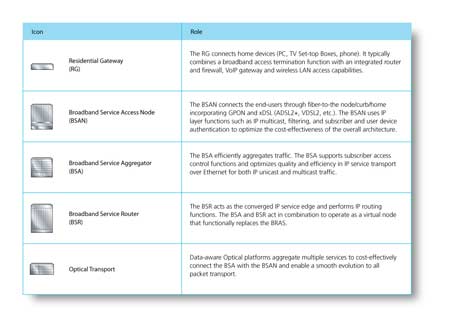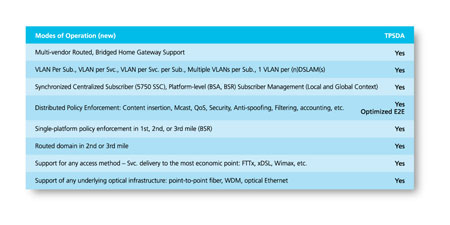L. Ciangiulli, R. Mestric
Transforming the Network for Triple Play
L. Ciangiulli, R. Mestric
Alcatel-Lucent's Triple Play Service Delivery Architecture (TPSDA)
Introduction
Over the last two years, operators have made strategic business decisions to determine the viability of an IPTV business. Some operators have evaluated appropriate network architectures - with a few early adopters delivering sizable Triple Play roll-outs. In 2007 and beyond, we will see very large-scale IPTV and NGN voice commercial deployments; migration of the strategic high-speed Internet installed base; optimization of network operations; and service innovation with the blending of video, Web and telephony services. As the market dynamics continue to shift, competition becomes fierce and consumers and enterprises are no longer passive participants, but assertive influencers; the need for realizing mass-market delivery is becoming a reality.
A scalable, reliable, secure and flexible network is needed to meet this challenge.
In that context, Alcatel-Lucent's Triple Play Service Delivery Architecture (TPSDA) has become a de facto blueprint for operators to enable and accelerate Triple Play network transformations in large-scale voice, video and data roll-outs around the world. It is by far the most widely deployed end-to-end architecture for Triple Play networks today, with over 40 deployments to date. To the end user, it provides an assured Quality of Experience; to the operator, a proven and cost-optimized network foundation for fast service roll-out with flexibility for future growth and service innovation.
TPSDA is one of the main solutions when transforming a network to a converged all IP-based network. This illustrates the first chapter of our AcuityTM Transformation Framework - Network Transformation.
Triple Play calls for Network Transformation
Many operators around the world have determined that current infrastructures, optimized for traditional high-speed Internet (HSI) service, cannot address the full range of Triple Play requirements. Indeed, HSI-optimized platforms were not designed for the required bandwidth capacity, Ethernet density, service richness, quality of service (delay/jitter/latency, etc.) and high-availability characteristics that are essential for always-on, always-available Triple Play services. Neither were they designed to handle the high rate of change associated with new dynamic and real-time services that are highly unpredictable in nature (large subscriber bases, volatile channel changes, varying demographics, numerous types of shows, live events, breaking news, etc.). Operators who try to repurpose HSI implementations to meet Triple Play service requirements face costly platform proliferation, poor network performance, and increased risk of customer churn due to an unsatisfactory Quality of Experience.
Triple Play services require a tightly controlled IP infrastructure able to support stringent quality of service (QoS) requirements, combined with highly reliable, scalable, non-stop service delivery of voice, video and data. Alcatel-Lucent's TPSDA has emerged as an industry best practice to address Triple Play requirements in a cost-optimized manner, to improve profit potential and deliver superior Quality of Experience to the end user.
Alcatel-Lucent TPSDA
The Alcatel-Lucent TPSDA is a network reference architecture that describes access, aggregation, edge and subscriber service delivery as an integrated solution, and addresses requirements for Triple Play (see Figure 1). Components of TPSDA are listed in Table 1.

Key design goals for the TPSDA are scalability and flexibility, in order to deliver innovative and profitable services that meet stringent user expectations for a flawless Quality of Experience. To achieve this, TPSDA leverages market-leading products (see Table 1), and optimally distributes the required intelligence throughout the network:
Distributing the functionality and intelligence between the nodes in the network alleviates scaling and QoS issues for bandwidth-intensive services, and allows operators to better optimize the network for future services.
In addition, integrated subscriber, home and service management provides a centralized and reliable management and control infrastructure for delivering user-centric broadband services, and efficiently administers the various policies that need to be configured in the TPSDA end-to-end.

Assured Quality of Experience
The foundation for Triple Play success is to ensure a flawless user experience, enabling people to do what they want - watch, play, talk, listen - whenever they want. When it comes to video and audio services, end users have very high expectations and a very low tolerance for anything but a positive experience. QoS issues will immediately be perceived by end users as degrading sound or picture, resulting in increased customer churn. The Triple Play network must provide an assured Quality of Experience, and in order to achieve this capability, certain considerations need to be taken into account.
Non-stop service delivery
Video and audio services are "always-on" services that cannot accept unpredictable network recovery timeouts and best-effort QoS implementations. The Triple Play service delivery network must therefore be capable of delivering always-on service.
Alcatel-Lucent's TPSDA provides a highly available infrastructure foundation. One of its foremost differentiators is the ability to deliver non-stop routing services to reduce the risk of service outages due to node or link failure. The underlying products are purpose-built to meet and exceed the most stringent reliability demands of operators, with a hardware and software architecture designed for maximum uptime. All Alcatel-Lucent platforms in the TPSDA are fully redundant platforms with no single point of failure, implementing a real-time, modular operating system that has been proven and production-hardened in many major large-scale broadband deployments worldwide.
At the network level, rapid protection and restoration mechanisms can be implemented in the optical products (photonic, SONET/SDH or packet layer), between the BSAN and BSA (multi-chassis Link Aggregation Groups to protect Gigabit Ethernet (GbE) uplinks) or BSA and BSR (MPLS fast reroute). Alcatel-Lucent's implementation enables restoration around a link failure in less than 50 milliseconds.
Mark Bieberich,
Director, Yankee Group
Bandwidth scaling
One of the key challenges for operators is to build an infrastructure that is optimized for today's offering and can scale for future needs. The most apparent change brought by Triple Play, in particular due to the video component, is the massive increase in bandwidth to be aggregated and transported in the network. To support video services, the architecture must be optimized for sustained high-bandwidth demand, and it must scale cost-effectively from a basic broadcast TV service offering to a mass-market uptake of Video on Demand (VoD) and Internet video. This gives operators the opportunity to "right-size" their investment over time to optimize their capital expenditure (CAPEX) investment as their networks evolve.
Today's predominant mode of video service is Broadcast TV (BTV). TPSDA incorporates the flexibility to optimize for BTV service now, and still scale bandwidth levels to support a full unicast model such as VoD and network-based Personal Video Recording (nPVR) at high-concurrency levels. BTV is optimized by implementing multicast packet replication and IGMP proxy multicasting in the BSAN, the BSA, the BSR and the optical layer. Multicasting increases the efficiency of the network by reducing the bandwidth and fiber requirements for delivering broadcast channels to the subscriber.
As video services mature, a higher percentage of unicast traffic will flow into the network, creating a greater bandwidth demand. TPSDA can efficiently scale to offer the required capacity, while always being able to give priority to the premium services (IPTV) over other video services (Internet video) in case of congestion:
Congestion avoidance
Assuring Quality of Experience for video is not just a matter of provisioning bandwidth capacity. Proper network dimensioning is essential, but not sufficient. A comprehensive approach to congestion avoidance is also needed to meet service quality, availability and cost objectives. In particular, service admission control can be a useful complement to other quality assurance mechanisms, to preserve service sessions in progress against the risk of quality degradation due to a network overload (e.g., extreme demand peaks or multiple link failures). In general, admission control only applies to session-oriented services requiring deterministic QoS and bandwidth guarantees to function properly (streaming video and real-time communications over IP).
Alcatel-Lucent's TPSDA supports both multicast service admission control (i.e., Broadcast TV) and unicast service admission control (e.g., VoD and streaming IP multimedia). A centralized policy control mechanism performs arbitration between service requests made by subscribers and available network resources, and guarantees service delivery when multiple services compete for the same bandwidth. Alcatel-Lucent deploys a centralized broadband policy server to support unified subscriber management and service delivery control for Triple Play. The policy-based authentication, authorization and accounting (AAA) and service admission control1 functions are tightly integrated and centrally administered, to close the loop on service authorization based on the subscriber service profile and network resource availability.
Service quality assurance
A resilient and scalable architecture, combined with a congestion-avoidance mechanism, contribute to increasing the probability that end users will receive the Quality of Experience they expect. The only way to be sure is by actually monitoring this Quality of Experience.
Alcatel-Lucent has the ability to collect usage and performance data along the entire service delivery path to verify and ensure that services are being delivered at the required quality. This allows potential problems to be diagnosed prior to performance degradation, enabling proactive actions to be taken, such as right-sizing capacity at perceived congestion points. Data is organized into reports and performance metrics, along with alerts and troubleshooting tools, so that operators can respond to increased demand, remedy potential quality issues, and isolate faults in the end-to-end network, from the home to the service source.
The troubleshooting operation can also be performed by the end user through a dedicated self-care application that will guide them through the different steps required to resolve a problem. This approach enables the operator to control OPEX while launching new services, without retraining operations staff.
The renowned independent test lab ISOCORE (www.isocore.com) has validated Alcatel-Lucent's TPSDA for mass deployment readiness.
Its report is now available at:
Read the ISOCORE Report
And a companion web seminar is available at:
Watch the companion web seminar
Deployment flexibility
TPSDA offers high flexibility in network deployment options within a well defined reference architecture. TPSDA supports any combination of access technology, home gateway, authentication protocol, connectivity model, subscriber management and policy enforcement, to cater to the specifics of any Triple Play service roll-out around the world (see Table 2). TPSDA supports "any mode of operation" including:

In summary, TPSDA caters to a multitude of network and deployment environments with different characteristics, like legacy infrastructure and network assets, region or geography specific characteristics, strategy, customer base, etc. This ultimate flexibility allows TPSDA to be adopted as the network foundation of any operator for Triple Play roll-out, whatever the requirements.
Jere Calmes,
Chief Operating Officer, Wind
Conclusion
While operators are embracing Triple Play to protect their customer bases and increase revenues, they face a transformation of their business model not only in terms of the new types of services and content they are offering, but also in their networks. The Alcatel-Lucent TPSDA provides the blueprint for this transformation for many of the largest Triple Play service roll-outs worldwide.
TPSDA is a network reference architecture that distributes service intelligence throughout the network to better address the requirements for Triple Play. It is unique in the market for its comprehensive and integrated end-to-end solution capabilities, and provides the ultimate deployment flexibility, allowing operators to optimize their service delivery infrastructure in anticipation of the mass adoption of Triple Play services. Both end users and operators alike benefit from TPSDA:
1 Service admission control is a mechanism that verifies that adequate capacity exists in the network to allow the user request (e.g., start of a VoD movie) to proceed.
Lisa Ciangiulli is Senior Marketing Manager, Wireline Business Group, based in Murray Hill, NJ, USA. Email: lciangiulli@alcatel-lucent.com
Roland Mestric is Director, Wireline Solution Marketing, Wireline Business Group, based in Villarceaux, France. Email: roland.mestric@alcatel-lucent.fr